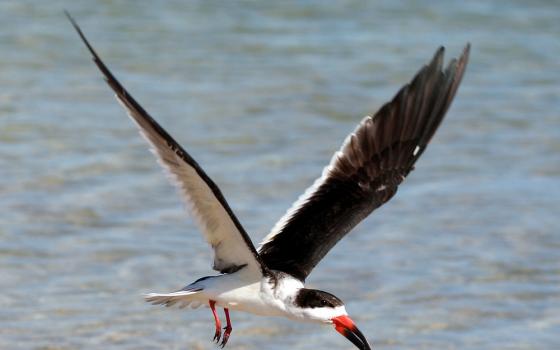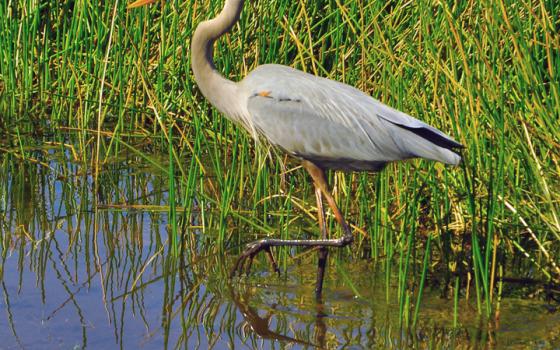While on retreat at St. Mary's by the Sea in Cape May Point, New Jersey, I love to visit the nature center near the lighthouse and to engage in one of my favorite forms of prayer — bird watching. One day, as I sat beside the pond that is often the haunt for interesting species, I became aware that birds have very different foraging styles.
As I waited peacefully for the action to begin, unexpectedly, a flock of six agile black skimmers appeared and glided gracefully in pairs very close to the surface of the pond, dragging their long knife-thin bills through the water. Endowed with eyes capable of seeing its red and black bill, skimmers have a unique advantage when searching for prey. To accomplish this task, they fly low and fast over the pond, slicing against its surface, beak open. As soon as their lower bills touch a fish, the skimmers snap their upper bills shut, scoop up the precious catch, and then wheel back to begin another dive, flying low and fast over the pond, slicing against its surface with their open beaks. Delighted with their catch, each pair turns and lifts in unison, dancing round and round over the surface of the water, their long wings flapping in sync.
After a few minutes, the skimmers left the stage to forage elsewhere.
Sometime later, a common tern joined the ritual, hovering over the pond with eyes focused intently on the surface below. Her long bill, forked tail and streamlined body provide her with the tools she needs to do her food-finding task. Once she spots her prey, she dives down, beak first, to retrieve a delicacy from the pond below. Satisfied with her catch, she, too, left the stage.
Eventually, a great blue heron arrived, waded into the deeper water, then poised statue-like, stalking its prey — elegant, perfectly still and utterly attentive. I stood to watch more closely. Suddenly and with lightning-fast speed, he thrust out his neck and head, stabbed his prey with his strong dagger-like bill, and ate it whole.
Skimming, diving, waiting — so many ways to forage for food, so many ways to be nourished. So what did I learn from this elegant drama? How do I find the nourishment I need to continue my work in the world?
I also search for spiritual nourishment in a variety of ways. Each morning I join my sisters in prayer. Usually, the six of us recite an updated version of the Divine Office, but once a week we share a practice our Sisters of St. Joseph call the State of the Heart. Like the black skimmers, we glide through the past week together in search of experiences of God's intimate presence in our lives. One by one, we skim the surface of our hearts, scoop up the graces that we find there and savor the morsels. After sharing our gifts, we take time to consider whether our lives are at all in sync — a profound way to build a sense of community among us.
There are days when my schedule is so packed that hovering over the deep seems almost impossible. So instead I soar like a tern as quickly as possible and plunge down into my depths to connect to my center and to devour the nourishment stored there. Not always the best way to begin a day, but certainly better than remaining hungry. Yet there are moments during the Eucharist when I can block out my inner chatter and focus on my interconnection with others, with the poor and with all of creation; when I can appreciate the food that the host symbolizes; when I can say yes to dealing lovingly with the hard things that I know will face me during the day.
Surely, the most precious moments happen when I take time to wade in the deep waters, waiting and watchful, patient enough to endure the silence. Sometimes, nothing comes; at other times, I find myself totally distracted; at certain rare and precious moments, the call is tangible, the insight palpable, the way ahead obvious, and I can take and eat and swallow the graces whole. Relishing whatever comes my way, I rise like the heron, glide into the task ahead, more peaceful and ready to face the day, so grateful for the rich food that awaits me in every experience whether I notice it or not.
[Kathleen Duffy is a member of the Sisters of St. Joseph of Chestnut Hill, Pennsylvania. She is professor of physics at Chestnut Hill College, where she directs the Interdisciplinary Honors Program and the Institute for Religion and Science. She is editor of Teilhard Studies and the author of Teilhard’s Mysticism: Seeing the Inner Face of Evolution (Orbis Books, 2014).]


